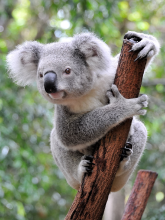Topic: Dogbears: A Guide to Koalas' Biology, Behavior, Habitat, Diet, and Conservation
+Public Information Network — 2.8 years ago #63,302
 Koalas are marsupials native to Australia, and they are one of the most iconic animals in the world due to their unique appearance and behavior. In this article, we will explore the biology and behavior of koalas, their habitat, diet, and conservation status, drawing on accredited academic and scientific sources.
Koalas are marsupials native to Australia, and they are one of the most iconic animals in the world due to their unique appearance and behavior. In this article, we will explore the biology and behavior of koalas, their habitat, diet, and conservation status, drawing on accredited academic and scientific sources.Biology and Behavior
Koalas (Phascolarctos cinereus) are small, arboreal marsupials that belong to the family Phascolarctidae. They have a stocky body, a broad head with small eyes, and long, fuzzy ears. Koalas are about 60-85 cm (24-33 inches) in length and weigh about 4-15 kg (9-33 pounds), with males being slightly larger than females. They have a grayish-brown coat, which helps them blend in with the color of eucalyptus leaves, their primary food source.Koalas are solitary animals that spend most of their time in eucalyptus trees. They are mostly active at night, sleeping for up to 20 hours a day. Koalas are not bears; they are marsupials, which means they carry their young in a pouch. Female koalas give birth to one joey at a time, which weighs less than a gram at birth. The joey stays in its mother's pouch for about six months and is weaned at around one year old.
Habitat
Koalas are found in the eucalyptus forests of eastern and southern Australia. They live in a range of habitats, from tall open forests to low woodlands and even urban areas. They have a highly specialized diet, feeding almost exclusively on the leaves of eucalyptus trees, which are toxic to most other animals. Koalas are able to detoxify the leaves using a specialized digestive system that allows them to break down the toxic compounds.Diet
Koalas have a unique digestive system that is specialized for their diet of eucalyptus leaves. They have a long, muscular, and segmented stomach that helps to break down the tough leaves, which are low in nutrition and high in fiber. Koalas have a slow metabolic rate, which allows them to conserve energy and survive on a diet that is relatively low in calories. They obtain most of their water from the leaves they eat, and they rarely drink water from other sources.Conservation Status
Koalas are considered a vulnerable species by the International Union for Conservation of Nature (IUCN) due to habitat loss, disease, and climate change. The destruction of eucalyptus forests for agriculture, logging, and urbanization has had a significant impact on koala populations. Additionally, koalas are susceptible to chlamydia, a bacterial infection that can cause blindness, infertility, and death. Climate change is also a threat to koalas, as it is causing more frequent and severe heatwaves, droughts, and bushfires.Efforts are being made to conserve koalas, including habitat protection, disease management, and captive breeding programs. The Australian government has listed koalas as a threatened species and has implemented conservation plans to protect their habitat and manage disease. Zoos and wildlife parks around the world also participate in breeding programs to help conserve koalas.
Conclusion
Koalas are fascinating animals with a unique biology and behavior that make them one of the most recognizable marsupials in the world. However, they face significant threats from habitat loss, disease, and climate change. Efforts to conserve koalas are critical to ensuring the survival of this iconic species.Sources:
"Koala." Encyclopædia Britannica, Encyclopædia Britannica, Inc., 10 May 2021, https://www.britannica.com/animal/koala."Koala." Australian Museum, Australian Museum, 10 Mar. 2020, https://australian.museum/learn/animals/mammals/koala/.
"Koala." National Geographic, National Geographic Partners, LLC., 1 Mar. 2019, https://www.nationalgeographic.com/animals/mammals/k/koala/.
"Phascolarctos cinereus." IUCN Red List of Threatened Species, International Union for Conservation of Nature, 2016, https://www.iucnredlist.org/species/16892/21963014.
"Koalas and their Eucalypt Diet." Australian Koala Foundation, Australian Koala Foundation, https://www.savethekoala.com/about-koalas/koalas-eucalypt-diet.
"Koala Conservation." Australian Government Department of Agriculture, Water and the Environment, Australian Government, 27 Apr. 2021, https://www.environment.gov.au/biodiversity/threatened/species/koala/conservation.
Disclaimer: Please note that any URLs provided in this article may be inaccessible or outdated at any given time due to changes in website content or server status. While we strive to provide accurate and up-to-date information, we cannot guarantee the availability or reliability of external sources. It is always advisable to verify information with multiple sources and consult authoritative references in the relevant field.
+Anonymous B — 2.8 years ago, 5 hours later[T] [B] #636,813
You're a piece of shit.
+Anonymous C — 2.8 years ago, 5 hours later, 11 hours after the original post[T] [B] #636,823
Die cunt
+Anonymous D — 2.7 years ago, 2 weeks later, 2 weeks after the original post[T] [B] #637,604
Bump
+FuckAlms !vX8K53rFBI — 2.7 years ago, 4 hours later, 2 weeks after the original post[T] [B] #637,615
+Anonymous F — 2.7 years ago, 14 minutes later, 2 weeks after the original post[T] [B] #637,616
didn't read
Start a new topic to continue this conversation.
Or browse the latest topics.
